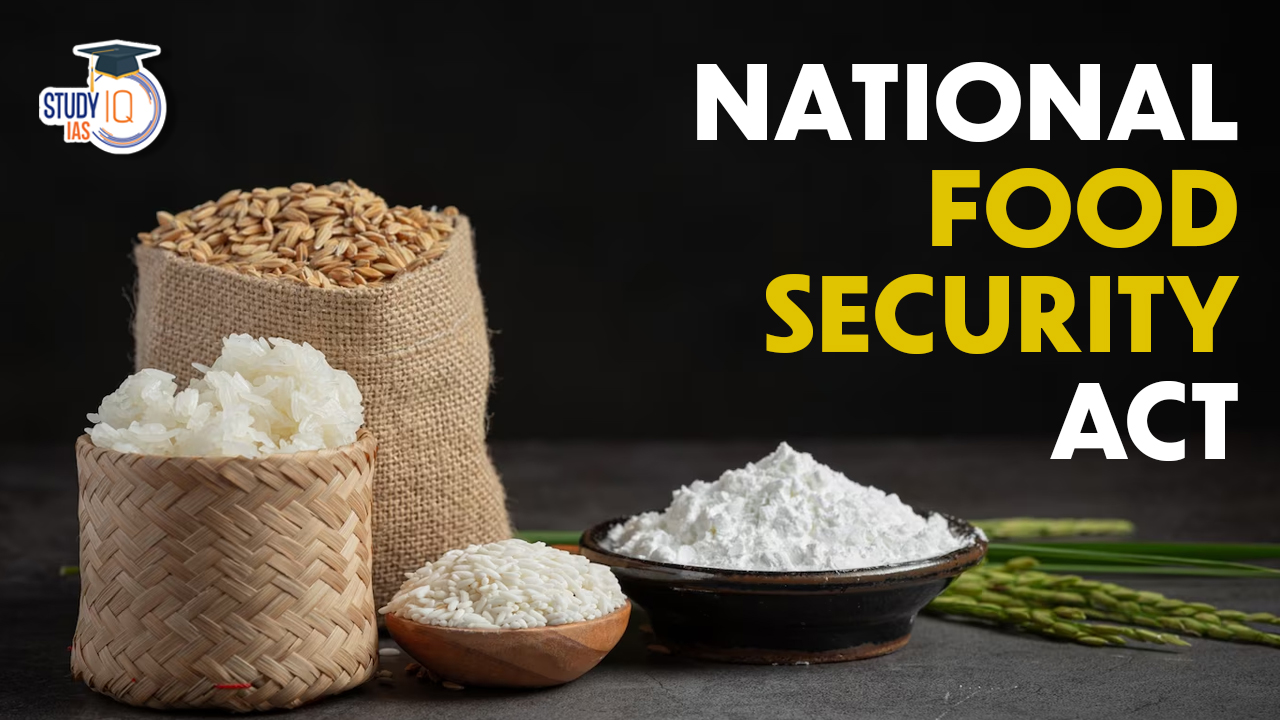Table of Contents
The National Food Security Act (NFSA) 2013 was passed to ensure access to appropriate quality food at reasonable rates for people to enjoy dignified lives, hence facilitating food and nutritional security in the human life cycle approach.
With a human-centered approach, the National Food Security Act seeks to provide food supplies and nutritional security. This is accomplished by ensuring that people have access to appropriate amounts of wholesome food at prices they can afford to support a respectable lifestyle. The National Food Security Act (NFSA) suggests a significant change in how we view food security.
About National Food Security Act 2013
Up to 75% of the rural and 50% of the urban inhabitants are entitled to subsidised food grains, according to the National Food Security Act, or NFSA. The Targeted Public Distribution System (TPDS) is the authorised method for distributing this. The TDPS provides uniform monthly entitlements of 5 kg to 50% of the urban and 75% of the rural people. The poorest of the impoverished households would, nevertheless, receive 35 kg of food grains per household each month under the Antyodaya Anna Yojana (AAY). Thus, this statute applies to approximately two-thirds of the population.
The National Food Security Act switches from a welfare-based strategy to one that is based on the rights of our nation’s residents. In every state and UT in the nation, the National Food Security Act (NFSA), 2013, is being put into effect. The process includes identifying beneficiaries by state or utility. It involves the cancellation of invalid, fraudulent, or duplicate ration cards, removal due to relocation or death, etc., and collaboration due to birth.
Objectives of NFSA
The National Food Security Act sought to integrate the idea of nutritional and food security into everyday living for people. It strives to offer adequate food of the greatest possible quality. The food needs to be accessible and affordable to those who really need it.
The act also strives to ensure that women and children receive the proper nourishment they need to live a healthy life. 75% of the rural population and 50% of the urban population are to get rationed food grains from the NFSA.
National Food Security Act Features
The National Food Security Act of 2013 (NFSA) currently contains laws that control the Public Distribution System (PDS). This law covers the Public Distribution System, the Integrated Child Development Services Programme, and the Midday Meal Programme. The NFSA 2013 also acknowledges the benefits of maternity leave.
According to demographic projections from the 2011 Census, the Act covers close to two thirds of the whole population of the nation. Under two categories, Antyodaya Anna Yojana (AAY) families and Priority households (PHH), 75% of the rural population and 50% of the urban population are eligible to receive substantially subsidised food grains.
Stata/UT The former Planning Commission, which is now NITI Aayog, decides on wise coverage based on the NSSO’s 2011–12 Household Consumption Expenditure Survey. For the purpose of identifying beneficiaries, many states use information from the Socio-Economic Caste Census (SECC). According to the Act, Antyodaya Anna Yojana households are entitled to 35 kg of food grains each month, while Priority Households are only entitled to 5 kg of food grains per person. For the purposes of distributing ration cards, the recipient household’s eldest lady (18 years or older) is referred to as the “Head of Family.”
Features of NFSA 2013 for Pregnant and Lactating Mothers
- Nutritional Support: Pregnant women, lactating mothers, and children (6 months to 14 years) receive nutritious meals under the Integrated Child Development Services (ICDS) and Mid-Day Meal (MDM) schemes.
- Enhanced nutritional standards are set for malnourished children up to 6 years of age.
- Maternity Benefit: Pregnant and lactating mothers are entitled to a minimum financial assistance of ₹6,000.
National Food Security Act 2013 Provisions
The federal and state governments are given joint responsibility under the National Food Security Act of 2013. According to the National Food Security Act of 2013, the centre is in charge of assigning and delivering food grains to designated depots in the states and UTs.
Additionally, the centre must coordinate with states and UTs to distribute food grains from authorised FCI godowns to the doors of Fair Price Shops. Identification of eligible households, ration card issuance, fair price shop distribution of entitlements, licencing and oversight of fair price shop (FPS) dealers, effective grievance redress mechanism establishment and improvement of the Targeted Public Distribution System (TPDS) are all tasks that fall under the purview of the states and union territories.
The National Food Security Act of 2013 also contains provisions for targeted improvements of the public distribution system, such as cash transfers for the supply of food benefits. The monetary equivalent of the subsidy is deposited directly into the bank accounts of qualified households via a programme known as Direct Benefit Transfer, which was first implemented in the union territories of Chandigarh and Puducherry.
National Food Security Act Significance
The National Food Security Act sought to integrate the idea of nutritional and food security into everyday living for people. It strives to offer adequate food in the greatest possible quality. The food need to be accessible and affordable to those who really need it.
The act also strives to ensure that women and children receive the proper nourishment they need to live a healthy life. 75% of the rural population and 50% of the urban population are to get rationed food grains from the NFSA.
National Food Security Act Beneficiaries
Two-thirds of the populace are covered by the statute under two primary categories of beneficiaries. The two recipients are intended to achieve the NFSA’s goals. These recipients are listed below:
Antyodaya Anna Yojana (AAY) Households
The AAY households are typically those of persons who live in poverty as well as those headed by widows, the disabled, or people 60 years of age or older without a secure source of income and assistance from their extended families or society. There is also support for women and children.
Priority Households (PHHs)
The NFSA offers people who reside in eligible households, or PHHs, the chance to receive food grains at a reduced price. A large fraction of those with priority sector ration cards are included in this group. The goal of this campaign is to fight poverty. The states in charge of the duties are in charge of determining whether families qualify under the TPDS coverage parameters established for each state.
Obligation under National Food Security Act
State Governments Obligations
Establishing mechanisms for grievance redress at the district and state levels, as well as identifying eligible households and issuing NFSA ration cards, as well as ensuring food grain allocations and the smooth operation of the public distribution system
Central Government Obligations
- Distribution of food grains to states in accordance with the beneficiaries’ names
- Offering money to fair pricing shop dealers for transportation, handling, and margins.
- Observing and assessing the NFSA’s implementation;
- Promoting accountability and openness in the food distribution system
Local Authorities Obligations
Identifying beneficiaries and assisting with the issuance of NFSA ration cards; monitoring the operation of fair pricing shops; conducting routine social audits; resolving complaints; and ensuring that the NFSA is implemented effectively.
National Food Security Act Criticism
The Act primarily addresses hunger and its eradication, but it neglects to address the negative effects of under-nutrition and how to address them. India’s biggest issue, malnutrition, cannot be resolved by simply establishing a public distribution system. In addition to assuring the availability of food, the distribution process includes critical components relating to water, sanitation, and health care.
Therefore, the Act must include both the right to food and the right to nutrition. Many localities have not yet benefited from Anganwadis, and their coverage is sometimes inadequate. It is difficult to imagine how the Act’s advantages will be realized in the absence of adequate resources. The Farmer’s Union also opposed the Act, arguing that it would nationalize agriculture and force the government to acquire, sell, and store the majority of agricultural output.
Additionally, it would lessen the support provided to marginal and small farmers and lessen the farmers’ ability to bargain. The Act also permits private businesses to participate in the supply chain, allowing for profit-making and dishonest business practices. The Public Distribution System’s leaks and corrupt practises in the supply chain are another barrier to the Act’s effective operation.
According to the Act, access to the right to food is prohibited during natural disasters and war. When it is most needed, the right to food will not be guaranteed to states that are extremely susceptible to natural calamities. Because this Act is being implemented in stages, it would take longer to accomplish the desired results.
National Food Security Act Amendments
In order to increase transparency and decrease leakages at ration shops during the weighing of foodgrains for beneficiaries, as well as to promote ePoS linkage with electronic weighing machines, an amendment to the Food Security (Assistance to State Government) Rules, 2015, has been notified.
The Consumer Affairs, Food, and Public Distribution Ministry has announced an amendment that intends to guarantee that beneficiaries of the National Food Security Act (NFSA), 2013, receive the right amount of subsidised food grains in accordance with their entitlement. Additionally, it pushes states to increase ePoS operational efficiency and generate savings while rewarding states that have been using it successfully.
The amendment stipulates that states can now use the savings to buy, operate, and maintain electronic weighing scales and integrate them with point-of-sale devices if they operate their ePoS devices wisely and are able to create savings from the additional margin of Rs 17 per quintal.
National Food Security Act UPSC
The National Food Security Act of 2013 is a significant step in the right direction, but it shouldn’t be the only one taken to solve the nation’s food poverty and hunger. In order to accomplish its objective, it needs to be restructured and new improvements must be incorporated in a number of areas. To help reach the Sustainable Development Goal of Zero Hunger by 2030, the effectiveness of the Act’s implementation is mostly dependent on the actions of the states, who are then followed by the Centre.


 BhashaSetu: Bridging Language Barriers w...
BhashaSetu: Bridging Language Barriers w...
 Tigers Outside Tiger Reserves (TOTR) Sch...
Tigers Outside Tiger Reserves (TOTR) Sch...
 Small Savings Schemes: Possible Interest...
Small Savings Schemes: Possible Interest...





















